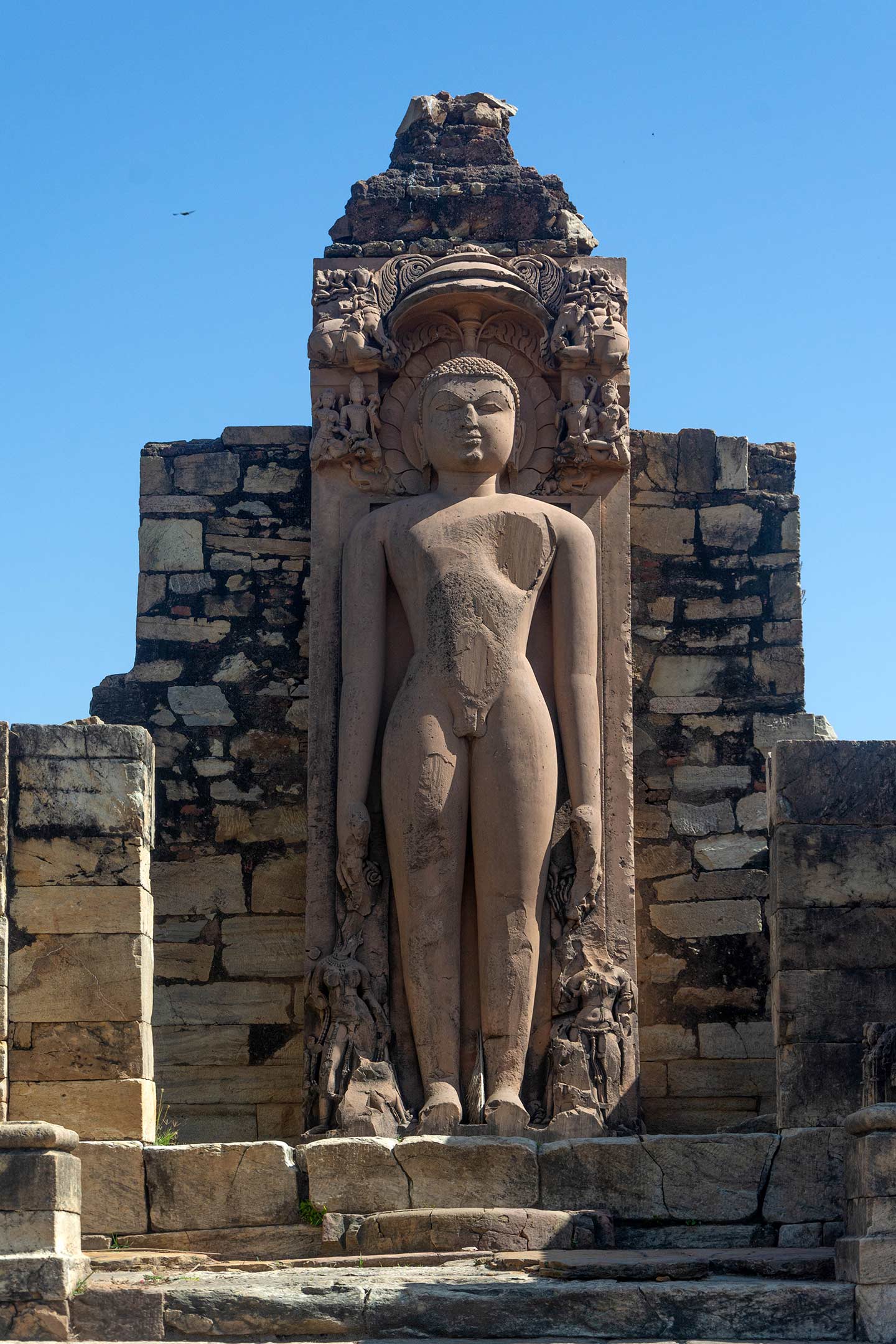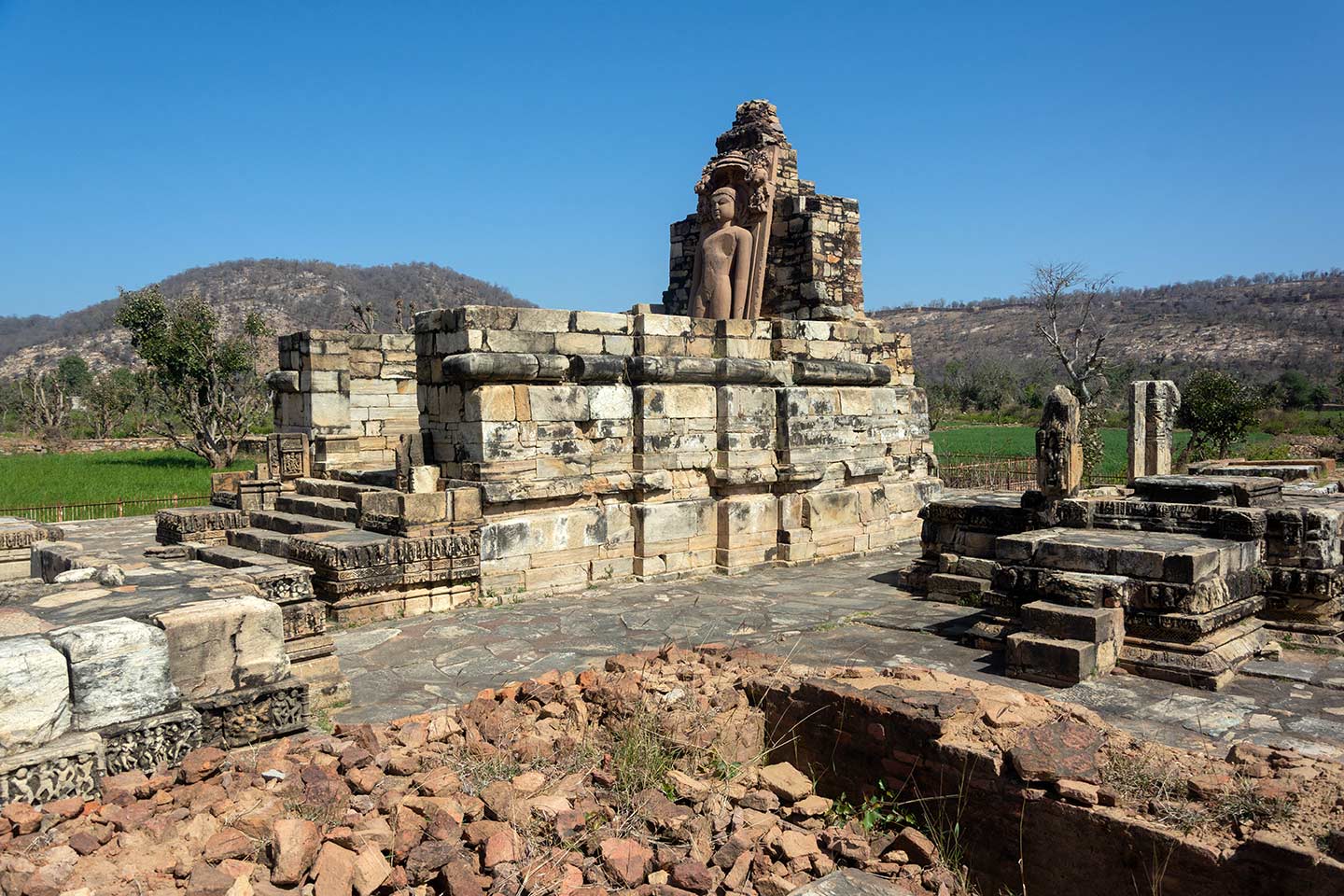Colossal Jina: The Naugaza Temple in Rajorgarh
By Swapna Joshi
There are several temple remains in the dense forests of Sariska Tiger Reserve in Rajasthan's Alwar district. These remains belong to an old settlement, which was known first as Rajorgarh (Rajyapura) and then as Paranagara. Historically, the region was subject to the political suzerainty of dynasties such as the Pratiharas and Bargujars. There are over a dozen temples, mostly in ruins, dating from the 9th to 11th centuries CE. The Naugaza Temple of Shantinatha is one of the temples situated to the west of the Neelkanth Mahadev Temple, the best surviving temples in the Neelkanth Mahadev group of temples. The builders of this Jain temple erected a colossal image of Jina Shantinatha, the sixteenth Tirthankara, in the early 10th century CE. The National Museum, Delhi currently houses an inscription from its vicinity that dates the temple.

In British period records, there are fascinating descriptions of this life-size image. One such description comes from a report by Sir Alexander Cunningham, the first Director General of the Archaeological Survey of India (ASI). While on his tour of Rajputana, Cunningham wrote,
Two elephants support a colossal Jaina figure, standing 13 feet 9 inches high with a canopy 2 feet 6 inches overhead, in one of the ruined temples. The sculpture's overall height is 16 feet 3 inches, and its breadth is 6 feet. This demonstrates the immense scale of the temple, particularly the Jina. [sic][1]
Reports by Colonel James Todd, A.C.L. Carllyele, Maya Ram, and others contain similar accounts of appreciating the Jina image.
Inscriptional Evidence of the Naugaza Temple
Neither the original text nor its exact location in the Naugaza Temple is known. According to M.A. Dhaky's encyclopaedia entry on the site, the inscription dates back to 923 CE and documents the building of a temple for Jina Shantinatha. [2] The temple was built by Sarvadeva, who was a disciple of Surasena; both belonged to the Dharkata family. The temple construction was initiated with the support of a certain king, Pulindra, whose exact lineage is not known. Dhaky suggests that he may be from the Pratihara feudatories that rule the region. However, the relationship between Pulindra and the earliest known Pratihara king, Savata, from Rajorgarh, remains unclear. [3] The composition of the inscription is ascribed to Sagaranandi and Lokadeva, but no further details of the temple are in the inscription, in which case the architectural and sculptural details prove useful.
Sculptural Details of the Shantinatha Sculpture
The temple's garbhagriha (sanctum sanctorum) houses the standing image of Jina Shantinatha by its rear wall. The tall, nude statue is in kayotsarga posture (standing upright in meditation posture) and has a chhatra (parasol) above it. Jina's face has calm features, a slight smile, and hair arranged in curls. The sculpture exhibits slight damage to its hands, feet, and chest. Two sculpted female attendants flank the Jina near the feet, their damage preventing identification of their attributes. Similarly, vidyadhara couples, or celestial couples, flank the bust of the Jina on the makaras, which are mythical creatures attached to the chhatra above the Jina's head. This chhatra is a small umbrella protruding above the head of the Jina, and its lower portion is formed from a lotus medallion resting on a bracket formed on the makaras. Elephant sculptures, seated in pairs, flank this chhatra on either side. Such large statues of Jain tirthankaras are not very common. The sculpture undoubtedly evokes memories of the 10th century CE Gomateshwar statue in Shravanabelgola, the Gopachal rock-cut monuments in Gwalior, and the Jina statue at the Arthuna temple in southern Rajasthan. While the Gomateshwar statue is double in size compared to the Alwar statue, the Gopachal statues are part of a larger rock-cut monument. The sculptures in Arthuna belong to a later period, compared to the Naugaza sculpture. Thus a colossal image enshrined in a temple, such as the one seen at Naugaza in the 10th century CE, is rare.

Architectural Details of the Naugaza Temple
The temple housing the Jina Shantinatha image was likely a part of a larger complex, with several subsidiary shrines surrounding the main shrine. The temple complex's principal entrance faces westward. The entire complex rests on a high jagati, or raised plinth. The walls, shikhara (superstructure), and details of the interior of the main temple do not survive, but the plinth of the temple is extant. The moldings of the pitha (base plinth) are similar to those of the temple's vedibandha (upper plinth). It consists of plain band mouldings at the base, followed by a tall kumbha (pot-shaped) moulding, and a kapotapali (moulding resembling a parrot’s beak), which has designs of chaitya gavakshas (dormer windows) at regular intervals. The temple's plinth, consisting of plain-dressed stones, only features this ornamentation. The topmost visible moulding in the plinth remains is the kalasha (pitcher-shaped moulding). The partially surviving walls above are also plain and devoid of ornamentation. The eastern elevation of the temple features partial reconstructions of the wall portions. The garbhagriha's plinth continues to the mandapa (pillared hall), which follows the same moulding sequence. The mandapa is the entrance to the temple, which has two devakulikas (smaller single shrines) with low pedestals inside. These devakulikas' plinth mouldings and those of the side shrines that surround the main temple are similar. They consist of mouldings like the jadya kumbha (cyma reversa), bands of diamond motifs, graaspatti (band of kirtimukhas or face of glory), gajathara (row of elephants), and narathara (row of human figures). The stylistic pattern of the jadya kumbha moulding in these smaller shrines on the Naugaza Temple complex is comparable to the mouldings of temples at Harshnath, Atru, and Kiradu.
Presence of Jainism in Alwar
One of the oldest surviving Jain temples in Rajasthan is the Mahavir Jain Temple, located in the Osian area of the Jodhpur district. The patronage of the Gurjara Pratiharas led to the prevalence of Jainism in the Alwar region between the 10th and 11th centuries CE, as evidenced by the temple remains at Rajgadh, Ajabgadh, and Naugaza. The popularity of Jainism continued even through the 14th and 15th centuries CE. During the medieval period, Alwar gained prominence as a Jain pilgrimage site. [4] In the tirthamala texts (compilations of sacred places) written during this period, a legend describes Alwar as a place of sanctity dedicated to the Ravana Parshwanatha, meaning Ravana worshipped the image of Parshwanatha in this place. This legend has led to the designation of Alwar as the Ravana Parshwanatha tirtha (sacred site). It is also believed that the old town of Paranagar was named after Parshwanath Tirthankara. In this regard, the Jain temple and the Naugaza Temple's sculptural remains fit the region's religious context.
Though most of the temples in the Neelkanth group are dedicated to Shiva, this complex contains some vital and unparalleled Jain remains. The colossal image of Jina Shantinatha and the temple that houses this humongous sculpture are certainly Jain remains. A few other ruinous temples might also have been dedicated to the Jain tradition, a conjecture based on the plans of these temples. However, because of a lack of data, these remains are only stray Jain fragments in Rajorgarh. Hence, the Naugaza Temple, though in a dilapidated state, becomes one of the important archaeological records of Paranagara-Rajorgarh history.

Footnotes:
[1] Cunningham, Report of a tour in Eastern Rajputana in 1882-83, 126.
[2] Dhaky, Encyclopedia of Indian Temple Architecture North India Beginnings of the medieval idiom c. 900-1000 AD, 351-52.
[3] Dhaky, 351.
[4] Jain, Jainism in Rajasthan, 49-51.
Bibliography:
Cunningham, Alexander. Report of a tour in Eastern Rajputana in 1882-83, volume 20. New Delhi: Archaeological Survey of India, 2000. https://archive.org/details/in.ernet.dli.2015.35451/page/n5/mode/2up
Dhaky, M. A. Encyclopaedia of Indian Temple Architecture North India: Beginnings of Medieval Idiom c. AD 900–1000. New Delhi: American Institute of Indian Studies and Indira Gandhi National Centre for the Arts, 1998.
Jain, K. C. Jainism in Rajasthan. Gulabchand Hirachand Doshi, 1963.